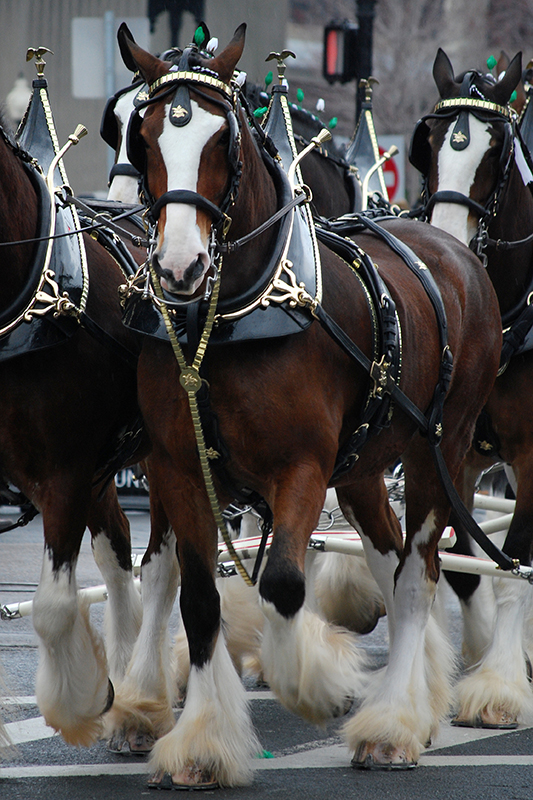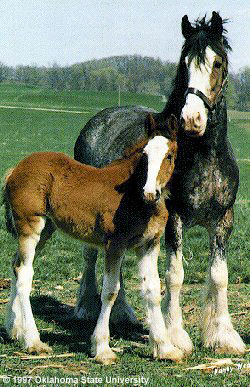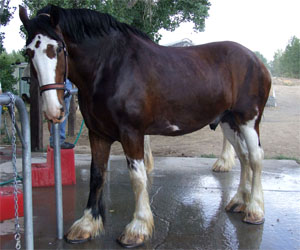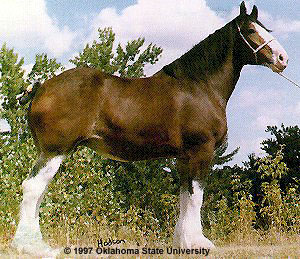Clydesdale Horses
The Clydesdale is a breed of heavy draft horse developed in and deriving  its name from the district in Scotland where it was founded. Its type was evolved
by the farmers of Lanarkshire, through which the River Clyde flows. The old name for
Lanarkshire is Clydesdale.
its name from the district in Scotland where it was founded. Its type was evolved
by the farmers of Lanarkshire, through which the River Clyde flows. The old name for
Lanarkshire is Clydesdale.
It was bred to meet not only the agricultural needs of these farmers, but the demands of commerce for the coal fields of Lanarkshire and for all the types of heavy haulage on the streets of Glasgow. The breed soon acquired more than a local reputation, and in time, the breed spread throughout the whole of Scotland and northern England.
The district system of hiring stallions was an early feature of Scottish agriculture and did much to standardize and fix the type of the breed. The records of these hiring societies go back in some cases to 1837. The Clydesdale Horse Society was formed in 1877 and has been an active force in promoting the breed not only in Great Britain but throughout the world. The Clydesdale alone, of the British breeds of heavy draft, has enjoyed a steady export trade to all parts of the world. The most active trade has been to commonwealth countries and the United States. Today the Clydesdale is virtually the only draft breed in its native Scotland and New Zealand. It holds a commanding lead in Australia and is popular, though not the numerical leader, in Canada and the United States.
 The Clydesdale is a very active horse. He is not bred for action, like the Hackney,
but he must have action. A Clydesdale judge uses the word "action" with a difference.
A Hackney judge using the word means high-stepping movement; a Clydesdale judge means
high lifting of the feet, not scuffling along, but the foot at every step must be
lifted clean off the ground, and the inside of every shoe be made plain to the man
standing behind. Action for the Clydesdale judge also means "close" movement. The
forelegs must be planted well under the shoulders - not on the outside like the legs
of a bulldog - and the legs must be plumb and, so to speak, hang straight from the
shoulder to the fetlock joint. There must be no openness at the knees, and no inclination
to knock the knees together. In like manner, the hind legs must be planted closely
together with the points of the hocks turned inwards rather than outwards; the thighs
must come well down to the hocks, and the shanks from the hock joint to the fetlock
joint must be plumb and straight. "Sickle" hocks are a very bad fault, as they lead
to loss of leverage.
The Clydesdale is a very active horse. He is not bred for action, like the Hackney,
but he must have action. A Clydesdale judge uses the word "action" with a difference.
A Hackney judge using the word means high-stepping movement; a Clydesdale judge means
high lifting of the feet, not scuffling along, but the foot at every step must be
lifted clean off the ground, and the inside of every shoe be made plain to the man
standing behind. Action for the Clydesdale judge also means "close" movement. The
forelegs must be planted well under the shoulders - not on the outside like the legs
of a bulldog - and the legs must be plumb and, so to speak, hang straight from the
shoulder to the fetlock joint. There must be no openness at the knees, and no inclination
to knock the knees together. In like manner, the hind legs must be planted closely
together with the points of the hocks turned inwards rather than outwards; the thighs
must come well down to the hocks, and the shanks from the hock joint to the fetlock
joint must be plumb and straight. "Sickle" hocks are a very bad fault, as they lead
to loss of leverage.
A Clydesdale judge begins to estimate the merits of a horse by examining his feet. These must be open and round, not thin and flat. The hoof heads must be wide and springy, with no suspicion of hardness that may lead to the formation of sidebone or ringbone. The pasterns must be long, and set out at an angle of 45 degrees from the hoof head to the fetlock joint. Too long a pastern is very objectionable, but very seldom seen.
 A Clydesdale should have a nice open forehead (broad between the eyes), a flat (neither
Roman-nosed nor "dished") profile, a wide muzzle, large nostrils, a bright, clear,
intelligent eye, a big ear, and a well-arched long neck springing out of an oblique
shoulder with high withers. His back should be short and his ribs well sprung from
the backbone, like the hoops of a barrel. His quarters should be long, and his thighs
well packed with muscle and sinew. He should have broad, clean, sharply developed
hocks, and big knees, broad in front. The impression created by a thoroughly well-built
typical Clydesdale is that of strength and activity, with a minimum of superfluous
tissue. The idea is not grossness and bulk, but quality and weight.
A Clydesdale should have a nice open forehead (broad between the eyes), a flat (neither
Roman-nosed nor "dished") profile, a wide muzzle, large nostrils, a bright, clear,
intelligent eye, a big ear, and a well-arched long neck springing out of an oblique
shoulder with high withers. His back should be short and his ribs well sprung from
the backbone, like the hoops of a barrel. His quarters should be long, and his thighs
well packed with muscle and sinew. He should have broad, clean, sharply developed
hocks, and big knees, broad in front. The impression created by a thoroughly well-built
typical Clydesdale is that of strength and activity, with a minimum of superfluous
tissue. The idea is not grossness and bulk, but quality and weight.
As in all breeds of livestock, the Clydesdale has gone through several changes of emphasis, over the years, to meet the demands of the times. In the 20's and 30's the demand was for a more compact horse; of late, it has been for a taller, hitchier horse. Most of the horses range in size from 16.2 to 18 hands and weigh between 1600 and 1800 lbs. Some of the mature stallions and geldings are taller and will weigh up to 2200 lbs. With the changes in the size and type of horse wanted, the Clydesdale emphasis on underpinning has remained paramount.
 The most common color in the Clydesdale breed is bay. Black, brown, and chestnut are
also seen with roans (solid body color with white hairs throughout the coat) in all
of the colors. The preferred markings are four white socks to the knees and hocks,
and a well-defined blaze or bald face. The show ring does not discriminate on color
with light roans and horses with dark legs being considered equally with horses of
the more solid colors and traditional markings. The increased popularity of big hitches
has directed more attention to color in recent years and the stabilization of color
patterns.
The most common color in the Clydesdale breed is bay. Black, brown, and chestnut are
also seen with roans (solid body color with white hairs throughout the coat) in all
of the colors. The preferred markings are four white socks to the knees and hocks,
and a well-defined blaze or bald face. The show ring does not discriminate on color
with light roans and horses with dark legs being considered equally with horses of
the more solid colors and traditional markings. The increased popularity of big hitches
has directed more attention to color in recent years and the stabilization of color
patterns.
For anyone desiring an active yet tractable, intelligent, stylish yet serviceable draft animal for work, show, or simple pleasure - the Clydesdale merits his or her most serious consideration.
References
Clydesdale Breeders of the U.S.A., 17378 Kelley Road, Pecatonica, IL 61063.
Phone: (815) 247-8780
